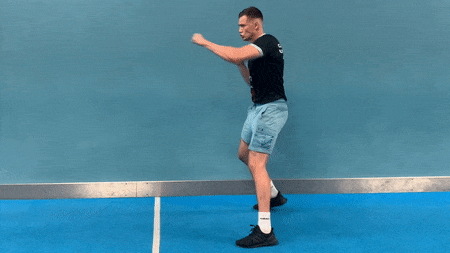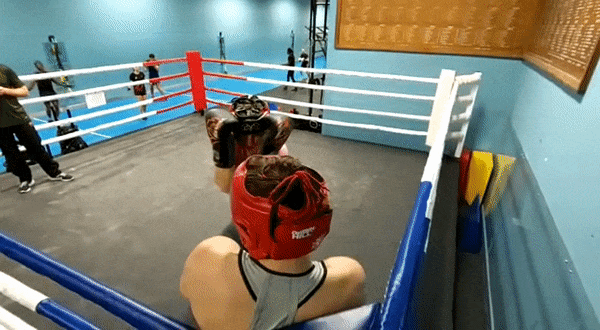In this article, I’ll be talking about how to practically train for a boxing match.
I will specifically cover the best activities to include in your boxing training when you have an upcoming fight—from exercises to mental preparation, we will talk about all the things that have helped me feel better prepared for a boxing match.
Stepping into the ring is scary.
Even after 20+ fights on my record, I still get the pre-match nerves right up until I am in the ring.
I particularly remember how clueless I felt training for my first-ever fight.
I wanted to work hard to give it my all in the ring but, at the same time, I knew I needed to let my body rest before the big night.
Now as a more experienced fighter, I wanted to put together all the advice I wish someone had told me back then.
I have used these training methods for all the important fights in my career that helped me win—including my competition representing Cambridge University at Town vs. Gown against a much more experienced fighter.

Here, I’ll cover everything needed to make sure to take home a win!
In a big shortcut, the truth is that with a month or two to go until the fight, it is very hard to learn new techniques beyond polishing what you already know.
So, while you should continue working on your technique, I’d recommend that you focus on the following that I consider to be the most important elements for training for a boxing match:
Shadowboxing
THE most important exercise in boxing.

Shadowboxing is crucial because it helps you to visualise your opponent’s movements so that you can practice the best combinations with precision.
Remember that when training for a boxing match, you should focus on training muscle memory and prepare your strategy to fit all the possible styles of your opponent.
You might know the type of opponent you will be fighting.
In that case, you should focus your shadowboxing on that specific style.
If he is shorter, shadowbox while moving on your toes and practising your in-out movement to keep your opponent at a distance.
If he is taller, focus on cutting distance and aiming at the body.
However, if you don’t know your opponent, try shadowboxing using different styles—the key here is to prepare yourself to respond to any type of fighter.
So, try rotating your sets based on different opponents. For example, visualise your opponent and practice shadowboxing as if they are:
- Shorter/taller
- Aggressive
- Southpaw
- Always on the back foot
- Very energetic
Rotate between these styles every round. Feel free to choose other styles apart from these.
I always advise my students to shadowbox as if they are fighting.
So, if you are doing 3, 2-minute rounds with a 1-minute break in between, then do the same with shadowboxing.
For a push, the last few shadowboxing trainings can be increased to 3, 3-minute rounds and 45-second breaks.
In short:
- 3 x 2min rounds; 1 min break (standard),
- 3 x 3min rounds; 45 sec break (advanced).
General Boxing Conditioning
There are physical attributes you want to focus on in a boxing match: explosiveness, speed, and power.
There are countless exercises to help you train these and there is space to get creative.
But let’s get into my personal favourites.
Exercises for explosiveness: standard push-ups, plyometric push-ups, explosive jumping jacks, burpees, kettle snatches, and jumping squats with weights.
Exercises for speed: shadowboxing with weights, changing pace on the heavy bag, medicine ball slams, and speed squats with punches.
Exercises of explosive power: punches on the resistance band, isometric hold, medicine ball explosive squat throws, and heavy punch bag session. You can find more exercises in our article on how to increase power.
Not sure where to begin?
Well, here is a basic beginner workout using some of these exercises.
Basic Beginner Conditioning Workout
Warm-up
- Jumping jacks: 1 set of 2 minutes;
- Jumping rope: 2 sets of 3 minutes.
Phase 1: Explosiveness
- Burpees: 3 sets of 10 reps;
- Plyometric Push-Ups: 3 sets of 10 reps;
- Jumping Squats with Weights (dumbbells or kettlebells): 3 sets of 10 reps.
Phase 2: Speed
- Changing pace on the heavy bag: 3 rounds of 2 minutes. Do the following in this drill. Alternate between fast, light punches and powerful punches.
- Shadowboxing with Weights: 3 rounds of 2 minutes while focusing on speed and footwork.
- Medicine Ball Ground Slams: 3 sets of 10 reps.
Phase 3: Explosive Power
- Punches on Resistance Band: 3 sets of 15 reps per arm;
- Medicine Ball Explosive Squat Throws: 3 sets of 10 reps;
- Power Punches Only On The Heavy Bag: 3 rounds of 3 minutes focusing on powerful punches and combinations.
Cool Down
- Stretching the entire body. Hold each stretch for 15-30 seconds and do at least 5 minutes.
If you are interested in finding more of these exercises, we have dropped the ultimate boxing conditioning course.
Here we provide 120+ boxing exercises and workout plans to take your conditioning to the next level—check it out below!
Cardio
One of the most important factors that affect your performance in a boxing fight.
At the beginner and intermediate levels in boxing (and even at high levels at times!), what win bouts are not technical ability, but stamina that allows you to carry your power, speed, reaction and explosiveness intact through the rest of your fight.
So having a solid base of stamina will allow you to focus on your opponent and win.
In my early fight days, this was the skill that I struggled with the most.
I hated the feeling of having to fight myself.
Gassing out sucks.
I advise dividing cardio training into two types of training. One should focus on high-intensity interval training (HIIT) that stimulates the fight, and the other should focus on more general conditioning.
Fight-style Cardio
This includes any activity that will imitate the fight and how you will feel in the fight like high pace work on the bag, sprints, high pace pads, change pace work on the bag, change pace pads, etc.
I would aim at training in similar intervals to what the fight is. So, if you are doing 3, 3-minute rounds with a 1-minute break in between—do at least the same interval in your fight-style cardio. I recommend doing 4, 3-minute rounds at an extremely high pace.
Remember that the aim is to simulate how the fight itself will make you feel.
General Cardio
The aim is to build lung capacity and conditioning to provide a good oxygen base.
My personal favourite is long runs. Aim to do 5 – 15 km at a steady pace depending on your conditioning level.
In true boxing style, you can also jump rope. Like I said before, try to make the training similar to the actual fight.
At minimum, you can do 3, 3-minute rounds with 30 seconds break in between. But I recommend doing 5, 3-minute rounds with proper jump roping form.
Play with the pace of the rope so you are getting close to how you feel in a fight. For example, I usually alternate between steady and very fast jumps every 15 seconds.
Sparring
The truth is that to prepare for a boxing fight—you must fight!

Sparring is the best way to prepare for your boxing fight. It brings together all the preparation you’ve done outside the ring so you can practice incorporating them in an actual fight.
You should spar the same number of rounds as you fight, if not more.
Sparring can help you practice different aspects of the fight. For example, some light spars can help you get a sense of your distance and try new things you’ve been practising.
Hard spars with demanding opponents will help you get familiar with the ‘fight mental zone’ and practice keeping calm in high-intensity scenarios.
You should get at least 4 sparring sessions including one heavy sparring session before your fight!
HOWEVER—don’t fight 7 days before your fight. You don’t want to injure yourself!
Rest and Recovery
Resting and recovering are as important when training for a boxing match.
Over the years, I’ve seen countless people who lost their fights because they overtrained and were too physically fatigued on fight day.
Boxing is one of the most physically demanding and gruesome sports there is. Failing to have proper rest may prevent you from showcasing your skills—all because your body has not physically recovered.
The last few days ahead of the fight should be spent on getting your body rested, hydrated, and recovered.
I recommend a sauna session (don’t overdo it!), a swimming pool session, a jacuzzi session, stretching on foam rollers and relaxing.
When it comes to training, focus on very low-intensity and shorter exercises such as jumping rope for a couple of minutes.
Take this time to listen to your body and take care of its needs.
Mental Preparation
Personally, a strong mind is just as important as a strong body in a fight.
The ability to stay calm under pressure and to fight through fatigue and intensity is fundamental to winning.
Visualise how the fight will go, how the opponent moves and how you would respond to it.
See yourself dominating the ring, what combinations you are throwing and even how you feel when your arm is raised to show you have won.
My advice is to figure out what you are scared of in the fight and work on lowering that pressure through visualisation and meditation.
Finally, be confident in your abilities!
You have trained very hard to be where you are now. Know that you have put the work in and now is time to show your talent!
You can do it!
Weight Cut
The chances are that if you have an upcoming fight, you have to make weight.
I personally think this is one of the toughest aspects when training for a fight because it can be very mentally demanding and even affect your performance in training.
Your main focus should be on planning with time.
Unless you find yourself having to shed 4-5 kg in 2/3 days, aim to shed those extra pounds with the least drastic change to your body.
When it comes to diet, the key is to minimise how much you eat without starving yourself of the nutrients you need to train. A rule of thumb is to avoid fibre (pasta, starches) and instead eat calorie-dense, high-protein food (like peanut butter!).
When I cut, I usually skip breakfast and stick to dishes like chicken breast with broccoli and spinach for lunch and eggs for dinner.
If you need more intensive weight-cutting tips, including other methods like sauna and cutting water weight, make sure to read our article on cutting weight for boxing.
Wrapping Up
So that was how to train for a boxing match.
Fight prep for boxing is hard.
There are many different things you need to think about like your stamina, recovery and even weight.
On this occasion, we looked at all the things you need to include to be fully prepared for your boxing match.
On the training side, try to simulate how you will feel in the fight as much as possible. For example, by shadowboxing, testing your stamina with long runs and sparring.
Also, take the time to rest and recover both physically and mentally. Allow yourself to heal and focus on strengthening your mind with visualisation and confidence.
Remember, you have already done the hard bit, now it’s time to make the final touches and step into the ring–you can do it!
Do you still want to learn more about how to build up your boxing conditioning to win your fight?
Then check out our course on the ultimate guide to boxing conditioning! We cover over 120+ boxing-specific exercises and provide you with training plans depending on your needs for your boxing fight. Check it out below.